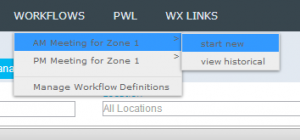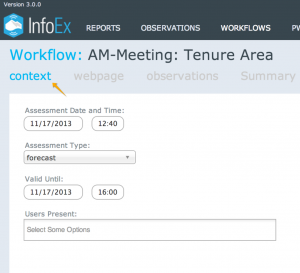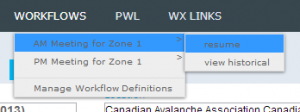Difference between revisions of "Executing a workflow instance"
(→Background) |
(→Saving the results of a workflow and sharing them with the InfoEx community) |
||
| (40 intermediate revisions by 3 users not shown) | |||
| Line 1: | Line 1: | ||
__NOTOC__ | __NOTOC__ | ||
| − | {{Requirements|UserLevel= | + | {{Requirements|UserLevel=Submission Moderator and higher|Connectivity=Online and offline}} |
| − | This document describes how to | + | This document describes how to execute a [[Definitions#WorkflowInstance|workflow instance]] from an existing [[Definitions#WorkflowTemplate|workflow template]]. |
==Background== | ==Background== | ||
| − | A workflow links together user-specified tasks into a logical order so that users can repeatedly move through the same steps. | + | A workflow links together user-specified tasks into a logical order so that users can repeatedly move through the same steps. See the following documents for more background information on workflows: |
| + | * [[Workflow overview]] | ||
| + | * [[Creating a workflow template]] | ||
| + | |||
| + | Executing a workflow instance involves three main steps: | ||
| + | # [[#Starting the desired workflow|Starting the desired workflow]] | ||
| + | # [[#Starting the desired workflow|Completing the steps included in the workflow]] | ||
| + | # [[#Saving the results of a workflow and sharing them with the InfoEx community|Saving the results of a workflow and sharing them with the InfoEx community]] | ||
| + | |||
| + | ==Step-by-step description== | ||
| + | |||
| + | ===Starting the desired workflow=== | ||
| + | |||
{|class="TblSteps" | {|class="TblSteps" | ||
|- | |- | ||
| − | |class="StepNum" | | + | |class="StepNum" | 1. |
| − | | | + | |[[File:WorkflowMenuStartNew.png|300px|thumb|right|Fig. 1: Workflow menu for starting a new workflow instance.]]From the WORKFLOWS menu select the workflow you want to execute and click on 'start new'. You need to be a Submission Moderator to have access to this menu item. The system will now load the necessary information for executing the chosen workflow. |
| + | {{Note|It is desirable to have a live internet connection when you initiate a workflow. This allows the system to pre-populate the fields of the [[Snowpack module]], [[Hazard assessment module]], [[Run list module]] and [[Hazard comment module]] with the information from the last time a workflow was submitted for the location(s) associated with the chosen workflow.|NoteWithImage}} | ||
| + | {{Note|You can initiate a workflow when you are offline, and the fields will be filled with the latest cached information on the computer. This will be up to date unless workflows have been submitted using other computers since you were last online on the computer you are currently using. However PWLs cannot be created (but can be updated) whilst offline and the run list extension does not work offline.|NoteWithImage}} | ||
|- | |- | ||
| − | |class="StepNum" | | + | |class="StepNum" | 2. |
| − | | | + | |[[File:WorkflowProgressSteps.png|300px|thumb|right|Fig. 2: Workflow progress]]After the necessary information has been loaded, the workflow will begin with the first step. The list of workflow steps is presented at the top of the workflow screen below the workflow title. |
| + | |} | ||
| + | |||
| + | ===Completing the steps included in the workflow=== | ||
| + | {{Note|Once a workflow has been started, you do not need to be online for completing the data entry steps. However, you need to be online to view any external webpages or InfoEx reports that are part of your workflow.}} | ||
| + | |||
| + | {|class="TblSteps" | ||
|- | |- | ||
| − | |class="StepNum" | | + | |class="StepNum" | 1. |
| − | | | + | |Complete the first step of the workflow as described in the relevant workflow module help document. See [[Documentation_overview#Workflow_modules|Workflow modules]] for more information on the functionality of individual workflow modules. |
|- | |- | ||
| − | |class="StepNum" | | + | |class="StepNum" | 2. |
| − | | | + | |[[File:WorkflowProgressControls.png|300px|thumb|right|Fig. 3: Workflow controls]] To move between steps use forward and backwards arrows in the workflow controls at the top right of the workflow area (Fig. 3). If you have specified that the steps of this workflow template can be completed in any order (see [[Creating a workflow template]] for more details), you can also navigate among the steps by clicking on the step labels at the top of the workflow screen below the workflow title. |
| + | {{Note|Once a workflow step has been completed, the workflow step label will be turned into a hyperlink and you can always directly go back to this step by clicking on its label.|NoteWithImage}} | ||
|- | |- | ||
| − | |class="StepNum" | | + | |class="StepNum" | 3. |
| − | | | + | |At any time during your workflow, you can click on the {{ButtonBlue|Discard & Exit}} button from the workflow controls (Fig. 3) to exit the workflow and delete all of the information that has been entered. |
| − | |||
| − | |||
| − | |||
| − | |||
| − | |||
| − | |||
|- | |- | ||
| + | |class="StepNum" | 7. | ||
| + | |[[File:WorkflowMenuStartResume.png|300px|thumb|right|Fig. 4: Workflow menu for continuing an existing workflow instance.]]If you want to exit the workflow, but save the information that has been entered into the workflow for future use (e.g., a lead guide prepares the workflow for an upcoming guides meeting), click on the {{ButtonBlue|Save & Exit}} button from the workflow controls (Fig. 3). This will save a copy of the workflow execution to your local computer for future use and redirect you to the report section. | ||
| + | {{Note|The information of a partially completed workflow is only stored on the computer where the workflow was started. This information is ''not'' stored on the InfoEx server or shared among the computers of the same operation.|NoteWithImage}} | ||
| + | To continue this particular workflow, click on the WORKFLOWS menu, select the particular workflow template and click on 'resume' (Fig. 4). | ||
|} | |} | ||
| − | == | + | ===Saving the results of a workflow and sharing them with the InfoEx community=== |
| + | [[File:WorkflowProgressControlsSubmit.png|300px|thumb|right|Fig. 5: Workflow controls with submit button enabled.]] Any workflow that includes workflow modules with data submission (click [[Documentation_overview#Workflow_modules|here]] for list of workflow modules with data entry), automatically has a [[Workflow summary|summary step]] included at the end of the workflow. Once you get to the summary step at the end of your workflow, the {{ButtonDarkBlue|Submit}} button will become enabled. | ||
{|class="TblSteps" | {|class="TblSteps" | ||
|- | |- | ||
| − | |class="StepNum" | 1. | + | |class="StepNum" | 1. |
| − | | | + | |On the workflow summary page, click on the {{ButtonDarkBlue|Submit}} button to save all of the associated observations and assessments and share the appropriate elements within the InfoEx community. See the documentation for the individual workflow modules for more information on what is shared. |
| + | {{Note|Please note that it is not possible to permanently save a workflow without sharing its content with the InfoEx community.}} | ||
|- | |- | ||
| − | |class="StepNum" | 2. | + | |class="StepNum" | 2. |
| − | | | + | |Confirm that you want to submit the information in the confirmation dialog. |
| + | {{Note|Note that once a workflow and the associated observations are submitted, you will not be able to edit them anymore.}} | ||
|- | |- | ||
| − | |class="StepNum" | 3. | + | |class="StepNum" | 3. |
| + | |Once you confirmed the submission, you will receive a series of system messages informing you about the upload status and the workflow navigation buttons will become disabled. | ||
| + | {{Note|See [[Viewing previously completed workflows]] for how to access completed workflows.}} | ||
|- | |- | ||
| − | + | |class="StepNum" | 4. | |
| + | |You can then generate or email (to the email list designated in the workflow definition) a pdf view of the workflow summary. Any single step can also be generated or emailed as a pdf. | ||
|} | |} | ||
==Related documents== | ==Related documents== | ||
| − | * | + | * [[Workflow overview]] |
| − | * | + | * [[Executing a workflow instance]] |
| + | * [[Viewing previously completed workflows]] | ||
| + | |||
==Functionality tested by== | ==Functionality tested by== | ||
| − | * | + | *Dec. 31, 2013: Pascal Haegeli |
| − | + | [[Category:Super User]][[Category:Operation Administrator]][[Category:Submission Moderator]][[Category: Offline]][[Category:Workflows]][[Category:Version 3.4.0]] | |
| − | |||
| − | [[Category:Super User]][[Category:Operation Administrator]][[Category: | ||
| − | [[Category:Offline | ||
| − | |||
| − | |||
Latest revision as of 14:49, 27 May 2019
| REQUIREMENTS | |
| Permission | Submission Moderator and higher |
| Connectivity | Online and offline |
This document describes how to execute a workflow instance from an existing workflow template.
Background
A workflow links together user-specified tasks into a logical order so that users can repeatedly move through the same steps. See the following documents for more background information on workflows:
Executing a workflow instance involves three main steps:
- Starting the desired workflow
- Completing the steps included in the workflow
- Saving the results of a workflow and sharing them with the InfoEx community
Step-by-step description
Starting the desired workflow
| 1. | From the WORKFLOWS menu select the workflow you want to execute and click on 'start new'. You need to be a Submission Moderator to have access to this menu item. The system will now load the necessary information for executing the chosen workflow.
| ||||
| 2. | After the necessary information has been loaded, the workflow will begin with the first step. The list of workflow steps is presented at the top of the workflow screen below the workflow title. |
Completing the steps included in the workflow
| NOTE | Once a workflow has been started, you do not need to be online for completing the data entry steps. However, you need to be online to view any external webpages or InfoEx reports that are part of your workflow. |
| 1. | Complete the first step of the workflow as described in the relevant workflow module help document. See Workflow modules for more information on the functionality of individual workflow modules. | ||
| 2. | To move between steps use forward and backwards arrows in the workflow controls at the top right of the workflow area (Fig. 3). If you have specified that the steps of this workflow template can be completed in any order (see Creating a workflow template for more details), you can also navigate among the steps by clicking on the step labels at the top of the workflow screen below the workflow title.
| ||
| 3. | At any time during your workflow, you can click on the Discard & Exit button from the workflow controls (Fig. 3) to exit the workflow and delete all of the information that has been entered. | ||
| 7. | If you want to exit the workflow, but save the information that has been entered into the workflow for future use (e.g., a lead guide prepares the workflow for an upcoming guides meeting), click on the Save & Exit button from the workflow controls (Fig. 3). This will save a copy of the workflow execution to your local computer for future use and redirect you to the report section.
To continue this particular workflow, click on the WORKFLOWS menu, select the particular workflow template and click on 'resume' (Fig. 4). |
Saving the results of a workflow and sharing them with the InfoEx community
Any workflow that includes workflow modules with data submission (click here for list of workflow modules with data entry), automatically has a summary step included at the end of the workflow. Once you get to the summary step at the end of your workflow, the Submit button will become enabled.
| 1. | On the workflow summary page, click on the Submit button to save all of the associated observations and assessments and share the appropriate elements within the InfoEx community. See the documentation for the individual workflow modules for more information on what is shared.
| ||
| 2. | Confirm that you want to submit the information in the confirmation dialog.
| ||
| 3. | Once you confirmed the submission, you will receive a series of system messages informing you about the upload status and the workflow navigation buttons will become disabled.
| ||
| 4. | You can then generate or email (to the email list designated in the workflow definition) a pdf view of the workflow summary. Any single step can also be generated or emailed as a pdf. |
Related documents
Functionality tested by
- Dec. 31, 2013: Pascal Haegeli


